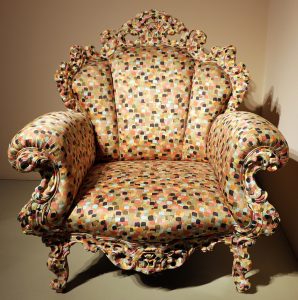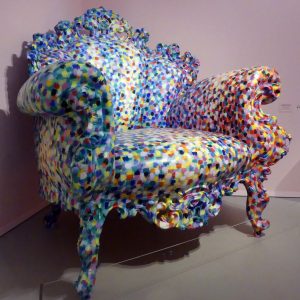Italian designer Alessandro Mendini’s 1978 Proust Armchair, realised in collaboration with the artist Franco Migliaccio, is one of the most iconic chairs of the last century. A precursor to Postmodernism, it was first put in production by the brand Magis.

A Literary Inspiration
In 1976 Mendini began to think about a “Proust fabric”, a textile inspired by the literary and pictorial influences associated with French writer Marcel Proust. He was particularly inspired by the themes explored in the book series In search of Lost Time and was fascinated by the concept of re-planning an old, simple piece of design following memories and fascinations linked to literature. The idea remained unexploited until two years later when it was implemented in the designing process of the “Proust Armchair”.

Image source: https://search.creativecommons.org/photos/c9cf2a0f-ac38-4d35-ac75-32a507e66688
Redesigning a Kitsch Armchair
In the second half of the 70s, Alessandro Mendini found an armchair in a fake 17th-century style, the perfect readymade for his literary-inspired ideas. At the same time, he was also fascinated by some details in Signac paintings, especially in its meadows, as well as by literature and combined all of these inputs in one action of design. The product of his work would be the Proust Armchair.
The chair thus created was peculiar in several ways: first of all, it followed an improper input for the usual designing process, secondly, it represented a culturally valid object created out of a fake one and lastly it was a piece of authentic design generated from a kitsch armchair.
As a result, Mendini‘s best-known work is usually considered the first in a series known as Redesigns. The series brought together the designer’s academic theories on the importance of historical context for design and the significance of surface appearance in a fast-moving world.

Image source: https://www.doppiozero.com/rubriche/1501/201807/la-poltrona-proust-di-alessandro-mendini
First Exposition and Production
The first Proust Armchair was presented during the exposition “Incontri ravvicinati di architettura” (Close meetings with architecture) in Ferrara in 1978 and then showed at the Venice Biennale. This very first example of the chair is now part of the Guido Antonello collection in Milan.
In the following ten years, another fifteen armchairs were realised, all of these were handmade and their crafting was always supervised by Mendini himself. Today, these chairs can be found either in museums all around the world or as precious specimens in private collections.
After a short break, the Proust Armchair production resumed in 1989. The production has never ceased since then and is currently entrusted to Claudia Mendini, niece of Alessandro, who paints every single armchair.

Image source: https://www.architectmagazine.com/technology/products/one-of-a-kind-magis-proust-armchair-in-lilac_o
Proust Armchair: Variations
The armchair has several variations:
In 1993 Cappellini produced the “Proust Geometrica“, an armchair that preserved the form and geometry of the original Mendini chair but differed in fabric, decorations and colour.
Magis designed a version of the armchair entirely made of polyethylene available in six different hues and suitable for exteriors.
In 2009 Superego, with the approval of the author, sold a limited series of ceramic miniatures of the Proust Armchair which were 40 cm high and in 2014 Mendini made a version entirely in Carrara marble for Robot City.

Image source: https://hivemodern.com/pages/product4252/cappellini-alessandro-mendini-proust-geometrica.
Data Sheet
- Designer: Alessandro Mendini;
- Year of design: 1978;
- Manufacturers: Atelier Mendini, Cappellini, Magis, Superego, Robot City;
- Materials: armchair with hand-carved and hand-painted wooden frame, upholstered with fixed multicolour fabric matching the base colours.

Image source: https://www.deplain.com/it/proust-poltrona-cappellini.html
Info sources:
https://www.dezeen.com/2015/08/04/magis-alessandro-mendini-proust-armchair-plastic-first-time-production/
https://it.wikipedia.org/wiki/Poltrona_Proust
https://www.cappellini.it/en/products/sofas-and-armchairs/proust
